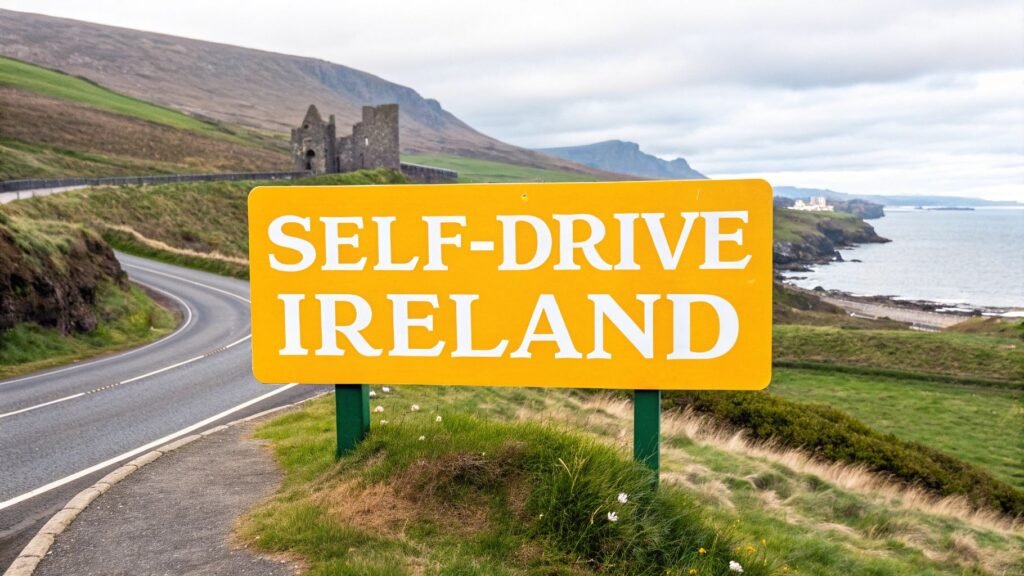Picture this: drifting from one sun-drenched Greek island to the next, each with its own vibe and personality. That’s the real magic of island hopping – it’s less about a fixed holiday and more about crafting your own adventure across the Aegean.
Kicking Off Your Greek Island Adventure
Think of a Greek island hopping trip not as a strict itinerary, but as a flexible way to explore. You're in charge. You get to decide whether you’ll spend an extra day exploring the volcanic coastline of Milos, dive into the legendary nightlife of Mykonos, or seek out some peace and quiet on a lesser-known gem like Folegandros. This guide is here to give you the practical, real-world steps to make that dream a reality.
The brilliant thing about this kind of travel is how adaptable it is. It works just as well for a backpacker staying in budget-friendly hostels as it does for someone looking to unwind in chic boutique hotels. The journey between islands—gliding across turquoise water on a ferry—is a huge part of the experience itself.
What Makes Island Hopping So Special?
Unlike sticking to one spot, an island-hopping tour is an ever-changing experience. Every island has its own unique character, carved out by centuries of history, its specific landscape, and the local culture. This constant change of scenery is what keeps the adventure feeling fresh and exciting from start to finish.
Here's what really sets it apart:
- Variety: You get to see so much in one trip. One day you could be on volcanic Milos, and a few days later, you could be surrounded by the lush green hills of the Ionian islands.
- Flexibility: You call the shots. Build a trip that’s all about what you love, whether that’s ancient history, buzzing beach bars, total relaxation, or outdoor adventures.
- Authenticity: Hopping between islands gives you a real glimpse into different sides of Greek life, from the busy energy of a port town to the slow pace of a tiny, traditional village.
- Adventure: There’s a genuine sense of discovery that comes with travelling by sea. It’s an element of journey that you just don't get from staying in one place.
A great island-hopping plan feels less like ticking off a list and more like a seamless adventure. The trick is to build a rhythm that mixes travel days with proper downtime, so you can actually soak up the atmosphere of each place without getting exhausted.
The Four Pillars of Planning
Nailing your Greek island hopping trip really comes down to four key things. Get these sorted from the beginning, and you're setting yourself up for a smooth, incredible holiday. You'll need to pick an island group, map out a sensible route, get to grips with the ferry network, and figure out a realistic budget. Let's dive into each of these, so you can start planning with total confidence.
Before we get into the nitty-gritty, here's a quick overview of the essential planning stages. Think of this as your master checklist.
Greek Island Hopping At a Glance
| Planning Pillar | Key Consideration | Best Time to Act |
|---|---|---|
| 1. Choose an Island Group | Match the island group's personality (e.g., Cyclades, Ionian) to your travel style. | 6-12 months out: Research and decide. |
| 2. Craft Your Itinerary | Decide which islands to visit and for how long. Don't over-pack your schedule! | 4-6 months out: Finalise your route. |
| 3. Book Transport & Stays | Secure ferry tickets and accommodation, especially for July and August. | 3-5 months out: Start booking. |
| 4. Finalise Your Budget | Estimate daily costs for food, activities, and extras. Have a contingency fund. | 1-2 months out: Refine your budget. |
Getting these four pillars right is the foundation of a trip that’s both thrilling and completely stress-free.
Choosing Your Perfect Greek Island Group
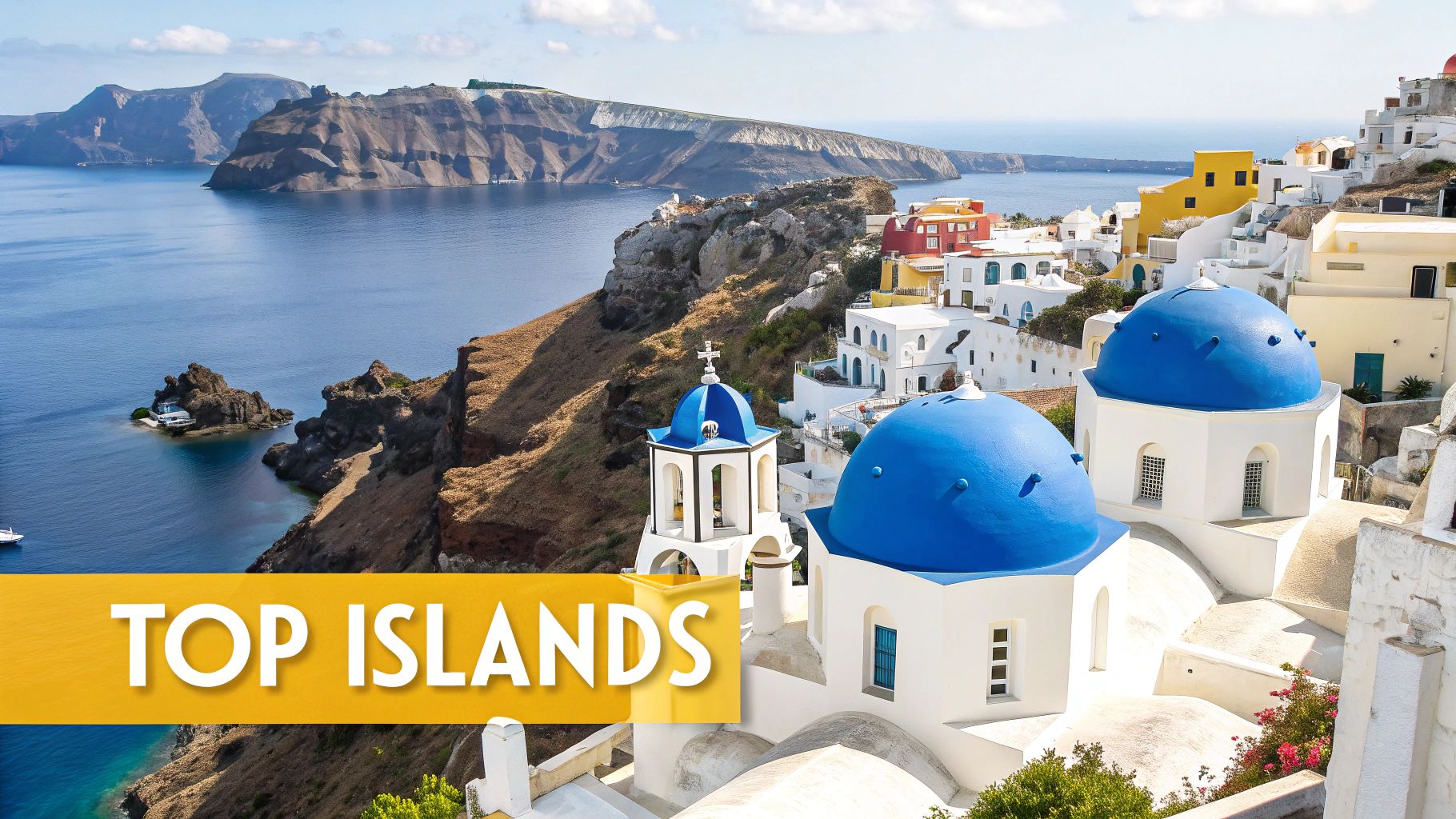
The very first, and most crucial, decision for any Greek island hopping trip is picking which island group to explore. Think of it as choosing the whole theme for your holiday. Each archipelago has its own distinct personality, history, and landscape, and your choice will set the tone for the entire adventure.
With over 200 inhabited islands scattered across the Greek seas, it's tempting to just pick names you've heard of. A much better approach is to focus on one cluster. This simple decision makes travelling between islands a breeze – it’s quicker, cheaper, and means you spend far more time soaking up the atmosphere and less time stuck on a ferry.
The Iconic Cyclades
When you picture Greece, you're probably picturing the Cyclades. This is the land of brilliant whitewashed villages tumbling down cliffs, iconic blue-domed churches, and sun-drenched golden beaches. For first-timers wanting that quintessential postcard experience, this is absolutely the place to start.
The Cyclades are a massive hit with UK holidaymakers looking for that perfect blend of culture and breathtaking scenery. Unsurprisingly, ferry bookings from the UK spike between May and September, especially for routes connecting hotspots like Mykonos, Paros, and Santorini. The islands are conveniently close to one another, with many ferry trips taking less than 90 minutes, which makes hopping between them incredibly smooth. You can find more detail on this trend over at To Travel Too.
Here's a quick rundown of what makes the Cyclades special:
- Best For: First-timers, couples on a romantic getaway, groups of friends, and anyone looking for buzzing nightlife.
- Vibe: Glamorous, energetic, and impossibly photogenic.
- Popular Islands: Santorini (for romance and world-famous sunsets), Mykonos (for nightlife and luxury), Paros (a fantastic all-rounder), Naxos (great for families and amazing beaches), and Milos (for its unique, volcanic coastline).
The Lush Ionian Islands
Head over to the west coast of mainland Greece and you'll find the Ionian islands, which feel like a world away from the Cyclades. Forget arid landscapes; here you’ll discover verdant green hillsides carpeted in olive groves and cypress trees that roll right down to the most stunning turquoise waters. The Venetian influence is palpable, from the elegant architecture to the relaxed, almost Italian feel of the place.
This is the perfect archipelago if you’re someone who loves lush greenery and spectacular coastlines. The Ionian islands are also home to some of Greece’s most famous beaches, including the jaw-dropping Navagio (Shipwreck) Beach in Zakynthos.
- Best For: Nature lovers, families, sailing enthusiasts, and travellers seeking a more relaxed pace.
- Vibe: Green, laid-back, and culturally rich with a distinct Italian flavour.
- Popular Islands: Corfu (packed with history and great resorts), Kefalonia (for dramatic scenery and incredible beaches), Zakynthos (for its famous beaches and sea turtles), and Lefkada (which is so close to the mainland you can drive there).
The biggest mistake travellers make is trying to mix island groups—thinking they can easily pop from Santorini over to Corfu. The reality is that the ferry connections are incredibly long and impractical. Stick to one group to make the most of your holiday time and keep travel stress to a minimum.
The Historic Dodecanese
Nestled close to the coast of Turkey, the Dodecanese islands are drenched in history. This is where you come to find mighty crusader castles, wander through medieval old towns, and explore ancient archaeological sites, all just a stone's throw from a beautiful beach. Rhodes, the group's largest island, boasts a magnificent UNESCO-listed Old Town that feels like you’ve stepped straight back in time.
The Dodecanese offer a brilliant mix of deep historical exploration and lazy beach relaxation. They are also generally a bit less crowded than the big-name Cyclades, giving your trip a more authentic, grounded feel.
- Best For: History buffs, culture vultures, and anyone who wants a holiday that mixes sightseeing with sunbathing.
- Vibe: Historical, diverse, and just a little off the beaten path.
- Popular Islands: Rhodes (for its incredible medieval history), Kos (for ancient ruins and great beaches), Patmos (a key site of religious pilgrimage), and Symi (for its stunning neoclassical harbour).
Crafting Your Ideal Island-Hopping Itinerary
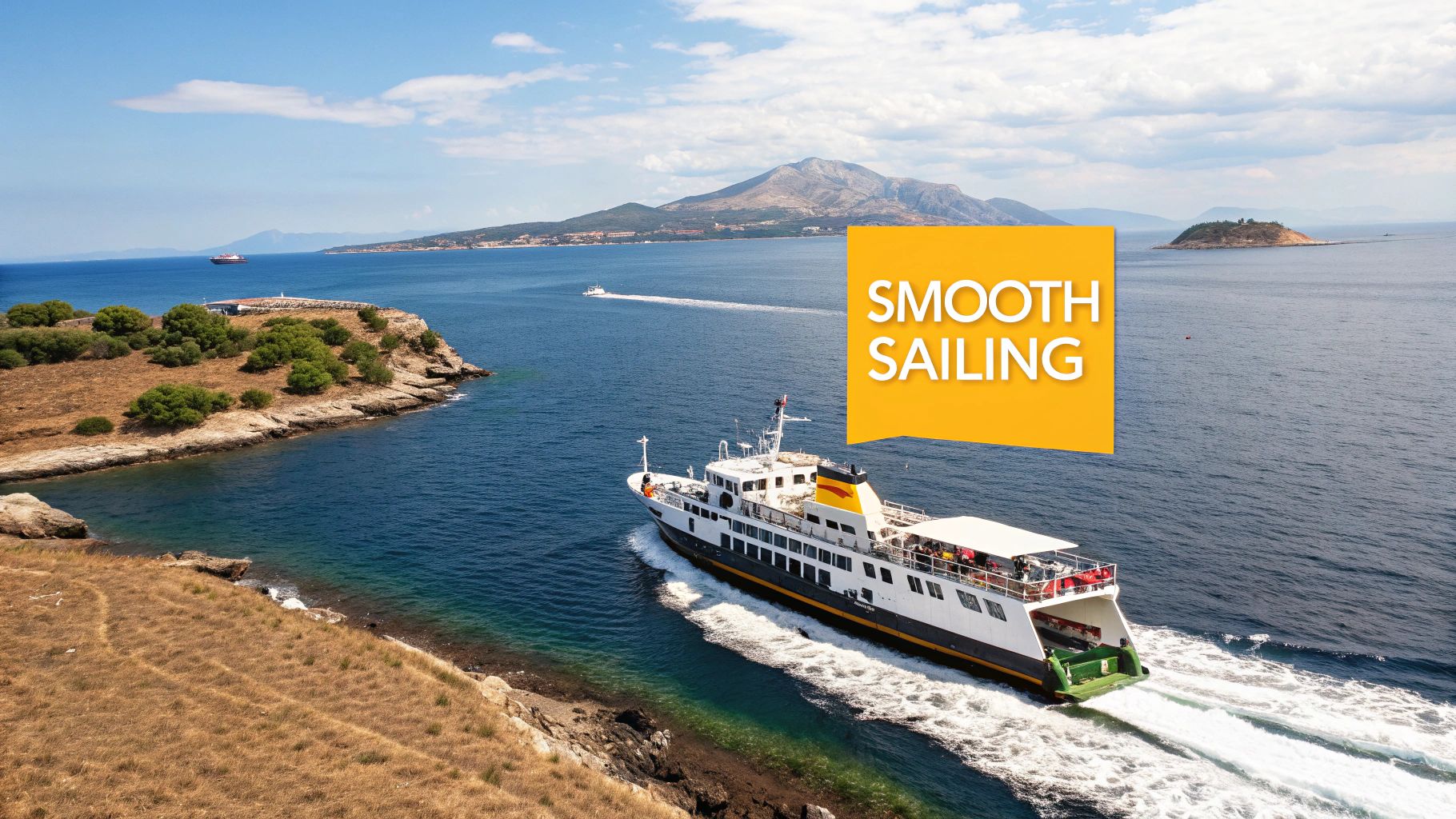
Alright, you’ve picked your island group. Now for the fun part: connecting the dots and mapping out your actual journey. A great itinerary is the secret ingredient to a perfect Greek island-hopping trip; it’s all about finding that sweet spot between exploring and simply relaxing. Trust me, a packed schedule is the fastest way to turn a dream holiday into an exhausting blur of ferry terminals.
Think of your itinerary as a flexible blueprint, not a rigid set of rules. The real goal is to create a logical flow that cuts down on travel time and gives you more quality time on each island. This usually means grouping islands that are close neighbours and have direct, convenient ferry links.
The Classic Cyclades Route for First-Timers
If this is your first time island hopping in Greece, you honestly can't go wrong with the classic Cyclades trio: Mykonos, Paros, and Santorini. This route is the quintessential Greek island experience, hitting all the high notes with iconic sights, gorgeous beaches, and buzzing towns. It's a well-trodden path for a very good reason—it’s efficient, absolutely stunning, and offers a little bit of everything.
Here’s a rough idea of what this popular route could look like:
- Mykonos (3 Nights): Kick things off here to soak up the vibrant energy, glamorous beach clubs, and iconic windmills. It’s the perfect, high-energy introduction to the Cycladic vibe.
- Paros (4 Nights): Just a short ferry ride away, Paros has a much more balanced feel. You can explore the picture-perfect fishing village of Naoussa, unwind on golden beaches, and even take a day trip to tiny, tranquil Antiparos.
- Santorini (3 Nights): End your adventure with the absolute showstopper. Witness those world-famous sunsets in Oia, discover unique volcanic beaches, and just soak in the dramatic caldera views.
This particular itinerary has really taken off with UK travellers. In fact, recent booking data shows that tourists from the UK, US, Canada, and Australia are spearheading a huge revival in Greek island hopping. The Mykonos–Paros–Santorini combination remains one of the top choices for UK holidaymakers, who love its perfect mix of nightlife, culture, and idyllic beaches.
An Off-The-Beaten-Path Cyclades Adventure
If you'd rather dodge the biggest crowds and find a quieter, more authentic side of the Cyclades, an alternative route can be incredibly rewarding. Islands like Sifnos and Milos serve up a more laid-back atmosphere without sacrificing an ounce of beauty or charm. This kind of itinerary is perfect if you’ve been before or if you’re just seeking a more relaxed pace from the get-go.
Consider this alternative plan:
- Sifnos (4 Nights): Famous for its phenomenal food and scenic walking trails, Sifnos is a real haven for anyone who appreciates understated charm and authentic Greek culture.
- Milos (5 Nights): An absolute dream for photographers, Milos boasts a spectacular volcanic coastline with over 70 unique beaches, from the moon-like landscape of Sarakiniko to the colourful fishing hamlet of Klima.
Of course, you can mix and match. A Milos–Naxos–Santorini itinerary is another crowd-pleaser, blending unique landscapes with family-friendly beaches and iconic views. For a fantastic pre-planned option, have a look at our Cyclades Islands Hopping tour visiting Santorini, Naxos, Paros, and Koufonissia.
Key Itinerary Tip: Always treat travel days as just that—travel days. A two-hour ferry ride can easily swallow half a day when you factor in checking out of your hotel, getting to the port, waiting to board, and settling into your new place. A good rule of thumb is to never plan any major activities on a day you're moving between islands.
Balancing Travel with Downtime
The single most important principle to remember is to avoid burnout. It's so tempting to try and cram as many islands as possible into one trip, but that’s a recipe for exhaustion. A more relaxed pace, with at least three nights per island, is a much better approach.
This gives you two full, uninterrupted days to explore without feeling like you’re constantly racing against the clock. For larger islands like Naxos or Milos, or if you simply want more beach time, extending your stay to four or five nights is even better. Remember, the goal is to come home feeling refreshed, not like you need another holiday to recover. As you plan, you might also want to look into specific regions, like a dream route through the Ionian islands, suitable even for beginners.
Mastering the Greek Ferry System
The iconic blue and white ferries are the lifeblood of any Greek island hopping adventure. They're the floating bridges connecting the dots of your itinerary, and getting a handle on how they work is your ticket to a smooth, stress-free trip. Don't think of the system as some complex logistical puzzle; it's more like Greece's public bus service, just on water, with different routes, speeds, and comfort levels to choose from.
Navigating this network is much simpler than it first appears. Really, it all boils down to one main choice: do you want a slow, scenic journey or a fast, direct one? The right answer depends entirely on your travel style, your budget, and how much time you have.
Conventional Ferries Versus High-Speed Catamarans
The real workhorses of the Aegean are the large, conventional ferries. These are the big, multi-level boats you’ve probably seen in photos, often painted in the liveries of companies like Blue Star Ferries. They take their time, but that’s a huge part of their charm. A trip on one of these is a classic Greek experience – think wide-open decks where you can feel the sea breeze, soak up the sun, and watch the islands slowly emerge from the horizon.
On the other hand, you have the high-speed catamarans and hydrofoils, often run by operators like Seajets. These are built for one thing: speed. They can slash travel times, sometimes by half, which is a massive bonus if you're on a tight schedule. But this efficiency comes at a cost. Tickets are pricier, and the ride can get pretty bumpy, especially if the famous ‘Meltemi’ winds decide to make an appearance.
Greek Ferry Types Compared
To make the choice easier, think of it this way. Are you prioritising the journey itself or just getting to the destination as quickly as possible? This table breaks down the key differences to help you decide which ferry is right for each leg of your trip.
| Feature | High-Speed Ferry (Catamaran/Hydrofoil) | Conventional Ferry (Car Ferry) |
|---|---|---|
| Best For | Travellers short on time; short hops between close islands. | Relaxed, scenic journeys; budget-conscious travellers; those prone to seasickness. |
| Travel Time | Significantly faster, often cutting journey time by 30-50%. | Slower and more leisurely. |
| Cost | More expensive, with ticket prices sometimes double that of a slow ferry. | The most budget-friendly option. |
| Onboard Experience | Enclosed seating (like an aeroplane), limited or no outside deck space. | Open-air decks, indoor lounges, cafes, and plenty of space to walk around. |
| Stability | Can be a very rough ride in windy or choppy conditions. | Much more stable in rough seas, making it a better choice for those prone to motion sickness. |
| Vehicle Transport | No. These are for passengers only. | Yes, this is the only option if you need to transport a car or motorbike. |
Ultimately, a mix of both often works best. Use the high-speed options for quick island hops where the journey is short, but for those longer, iconic routes, the conventional ferry experience is hard to beat.
Booking Your Ferry Tickets
If you’re travelling during the peak season from June to September, booking your main ferry routes well in advance is non-negotiable. Popular journeys, like Athens to Mykonos or Santorini, can sell out weeks ahead of time. I always recommend using a platform like Ferryhopper to compare schedules and prices from all the different companies in one place – it makes life so much easier.
That said, you don’t need to have every single trip locked down before you go. For shorter, less popular routes between smaller islands, you can often just wander down to the port and buy a ticket a day or two before you want to travel. This leaves some welcome room for spontaneity in your itinerary.
Insider Tip: Always, always check the weather forecast. If strong winds are predicted, do yourself a favour and book the big, slow ferry. A ride on a high-speed catamaran in rough seas is not just uncomfortable; it can lead to major delays or even cancellations that can completely derail your plans.
Getting to the Port and Onboard Logistics
For most people, the island hopping dream begins at Piraeus, the main port of Athens. It’s easy to get there from Athens International Airport; you can hop on the direct X96 bus, take the metro, or grab a taxi. Just be sure to allow plenty of time – the trip can take anywhere from 60 to 90 minutes. Piraeus is a massive place with different gates for different destinations, so double-check your ticket to see exactly where you need to be.
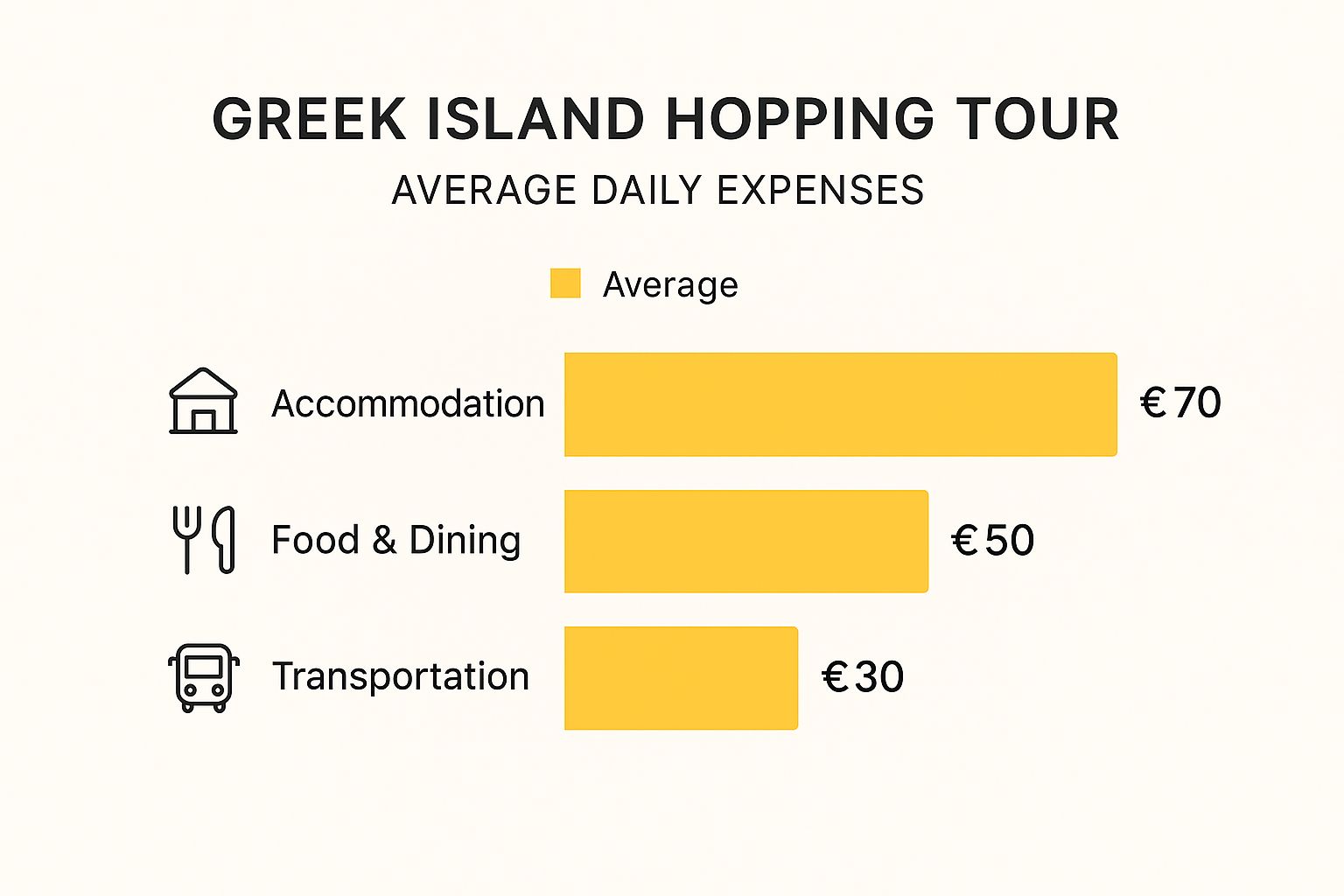
Once you’re on board, the vibe is pretty relaxed. The larger ferries have cafes, lounges, and loads of seating. And forget about the strict luggage rules you get with airlines. You simply wheel your bags on and leave them in the designated storage racks on the car deck before heading up to the passenger areas.
If you’re thinking about exploring beyond the Cyclades, the Ionian islands offer a completely different flavour of Greece. Our guide to an Ionian island hopping tour of Corfu, Ithaca, Kefalonia, and Zante has plenty of specific tips for that region.
Budgeting for Your Island Adventure
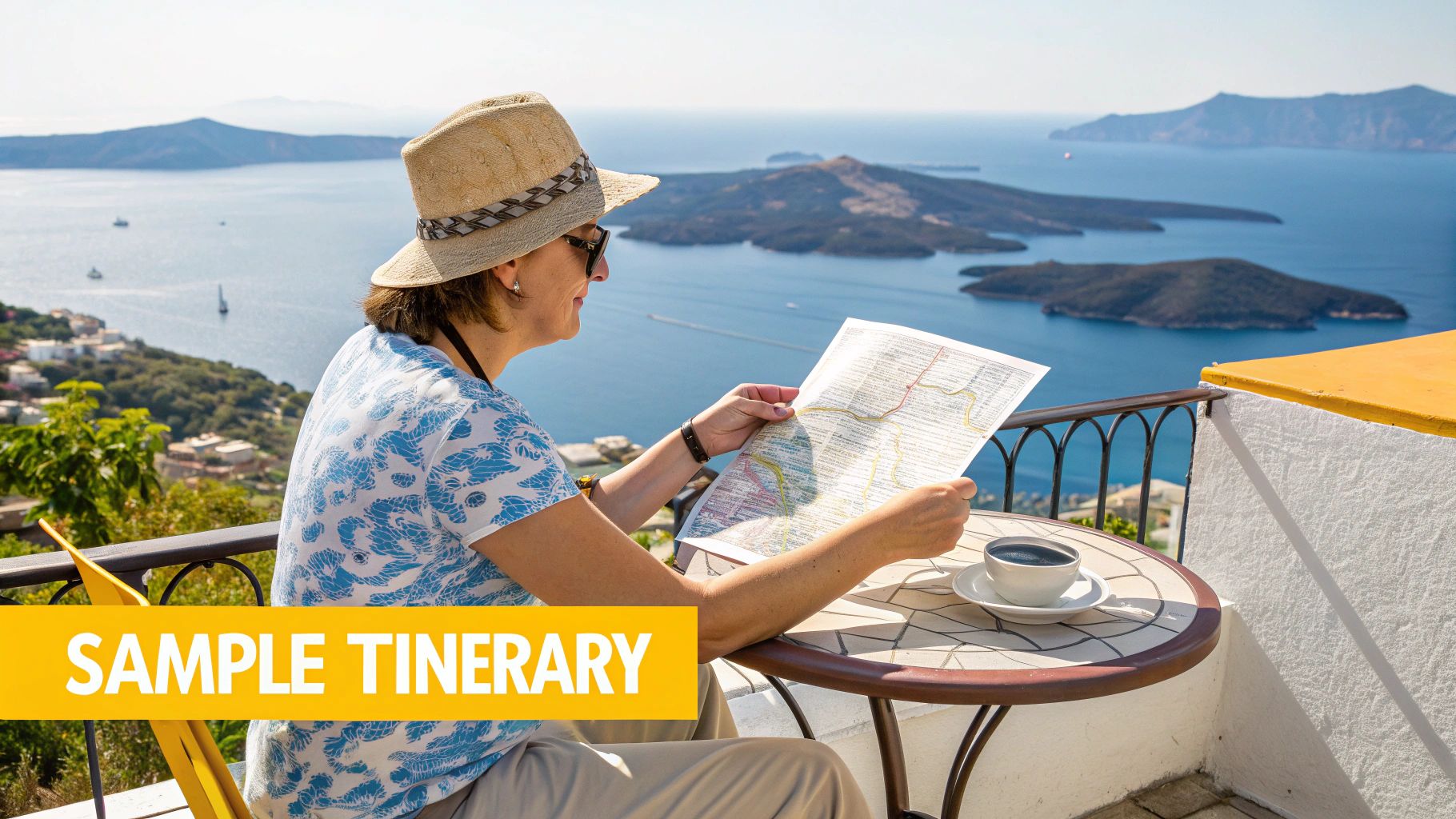
So, how much does a Greek island-hopping tour actually cost? The honest answer is that it can be as wonderfully affordable or as lavish as you want it to be. The real key to a fantastic, stress-free holiday is setting a realistic budget that suits your style before you go. That way, you can spend less time crunching numbers and more time soaking up that glorious Aegean sun.
Think of your budget not as a set of rules, but as your financial roadmap. Greece offers incredible value for money, especially when you stack it up against other Mediterranean hotspots. But costs can swing wildly from one island to the next, and the time of year you visit plays a huge role. A delicious gyros on Naxos will set you back a few euros, while a fancy dinner overlooking the Santorini caldera is a different story altogether.
To give you a clearer picture, we’ve broken down the estimated daily costs into three typical travel styles. These numbers are based on travel during the "shoulder season" (May-June and September). If you’re planning a trip during the peak months of July and August, be prepared to add 20-30% to these figures.
Daily Budget Breakdowns by Travel Style
Naturally, what you spend each day comes down to your choices in accommodation, food, and activities. Here’s a genuine look at what you can expect to spend per person, per day.
The Savvy Backpacker: €50 – €75 per day
This budget is perfect if you want to experience the absolute best of the islands without emptying your wallet. It’s all about making smart choices – think friendly hostels, incredible street food, and hopping on local buses to get around.
- Accommodation: Expect to pay €20-€30 for a dorm bed in a well-rated hostel.
- Food: €20-€25 will get you a fantastic mix of gyros, souvlaki, and treats from local bakeries, plus a casual taverna meal.
- Transport & Activities: With €10-€20, you can cover local buses and enjoy the best free activity there is: the beach!
The Mid-Range Comfort Seeker: €100 – €150 per day
This is the sweet spot for most travellers. It allows for a comfortable trip with room for a few well-deserved splurges. You’ll be staying in private rooms, enjoying relaxed taverna dinners, and maybe even renting a scooter for a day of exploring.
- Accommodation: €50-€70 will secure a clean, private room in a lovely guesthouse or a budget-friendly hotel.
- Food: A budget of €35-€50 covers casual lunches and very pleasant sit-down dinners, complete with local wine.
- Transport & Activities: Set aside €15-€30 for a mix of buses, the occasional taxi, and perhaps a fun boat trip.
The Luxury Traveller: €250+ per day
If you're looking to indulge, Greece certainly knows how to deliver. This budget opens the door to boutique hotels, fine dining, private transfers, and truly exclusive experiences.
- Accommodation: €150+ is the starting point for a stylish boutique hotel or even a villa with its own pool.
- Food: With €75+, you can enjoy gourmet meals at top-rated restaurants and sip cocktails at chic sunset bars.
- Transport & Activities: Your €25+ daily budget will easily cover taxis, private boat tours, or a rental car for ultimate freedom.
Keep in mind, these are just averages. A day spent lounging on the sand with a good book will cost a fraction of a day spent on a guided tour or hiring an ATV. The best way to stay on track is to simply keep an eye on your spending as you go.
Smart Ways to Save Money
Even a few small tweaks to your plans can make a huge difference to your overall spend. The single biggest money-saver is travelling during the shoulder season; prices for flights, ferries, and accommodation drop significantly.
Beyond timing your trip right, here are a few other tried-and-tested tips:
- Choose islands wisely. Instead of heading straight for Mykonos and Santorini, consider less famous but equally stunning islands like Naxos, Amorgos, or Folegandros.
- Book ferries in advance. You can often grab the best prices by booking tickets for major routes ahead of time, especially on the slower, more traditional ferries which are almost always cheaper.
- Eat like a local. Grabbing a €3 gyros for lunch is not only delicious but also frees up more of your budget for a lovely evening meal. Don't overlook bakeries – they sell all sorts of incredible and cheap savoury pies (called pitas).
To make managing your funds on the go even easier, it might be worth checking out some of the best free budgeting apps before you leave. A simple tool on your phone can help you see exactly where your money is going, ensuring your budget lasts for the entire adventure.
Essential Tips for a Flawless Trip
Beyond picking islands and booking ferries, it’s the little things that turn a good trip into a great one. These are the hard-won secrets that let you navigate your journey with the confidence of a seasoned traveller, avoiding the common pitfalls along the way.
First up, and I can't stress this enough: pack light. Seriously. Picture yourself wrestling a massive suitcase up a steep ferry ramp, rattling it over ancient cobblestones, or hauling it up three flights of stairs to your hotel room. A backpack or a light duffel bag isn't just a suggestion; it’s essential for your sanity. You'll be patting yourself on the back by your very first transfer day.
Navigating Local Nuances
Understanding the rhythm of Greek life is half the battle. You’ll hear the phrase "siga-siga," which means "slowly, slowly," and it’s a way of life here. Don't be surprised if shops close for a long siesta in the afternoon – just go with the flow.
One of the best pieces of advice I can give is to always greet shopkeepers or taverna staff with a friendly "Yassas" (hello) when you walk in. This small gesture is a sign of respect, and it’s amazing how it can lead to warmer service and a genuinely better experience.
Learning a few key phrases will get you far:
- Kalimera: Good morning
- Efcharisto: Thank you
- Parakalo: Please / You're welcome
These simple words really do open doors and help you make wonderful connections with the local people.
Planning and Flexibility
While leaving room for spontaneity is part of the magic, a bit of planning goes a long way. On smaller, popular islands, booking accommodation in advance is absolutely crucial, especially if you're travelling in July or August. The best spots are often snapped up months ahead, and showing up without a reservation is a recipe for stress and overpriced, mediocre rooms.
At the same time, you have to be ready for the unexpected. The infamous ‘Meltemi’ winds can roar through the Aegean in summer, sometimes leading to last-minute ferry delays or even cancellations. It's always a good idea to build a buffer day into your itinerary, particularly before your flight home. Never book your last ferry for the same day you're due to fly out.
This balance of planning and flexibility is the secret. Maybe you'll discover a quiet fishing village you can’t bear to leave and decide to stay an extra night. For anyone who wants a more structured adventure without sacrificing that feeling of discovery, a guided route like a Dodecanese island hopping tour of Kos, Kalymnos, and Patmos can offer the perfect blend. If you prepare for the basics but stay open to a change of plans, you’re set for the adventure of a lifetime.
Your Island Hopping Questions Answered
Even the most organised traveller has those last-minute questions that pop up just before a big trip. This is where we tackle the most common queries we get about Greek island hopping, giving you the practical, straightforward advice you need to finalise your plans with confidence.
Think of this as the kind of know-how you’d get from a friend who’s just come back, full of tips on the little details that make a huge difference. We’ll cover the best time to go, whether you really need to book ahead, and how to find that perfect, unhurried pace for your adventure.
When Is the Best Time to Go?
For the perfect balance of sun, sea, and sanity, aim for the shoulder seasons of May-June and September. The weather is beautifully warm—ideal for swimming and sightseeing—but you’ll miss the peak summer heat and the biggest crowds. As a bonus, you’ll find that ferry and accommodation prices are a lot friendlier on your wallet.
July and August are, of course, brilliant if you’re after buzzing nightlife and guaranteed scorching weather. Just be prepared for it to be much busier and more expensive. If you have the choice, the shoulder seasons offer a more laid-back experience.
The real sweet spot? I’d say early June. The sea has had a chance to warm up, every taverna is open for business, but the main summer rush hasn't quite hit yet. It’s the best of both worlds.
Do I Really Need to Book Everything in Advance?
This one really comes down to when and where you’re planning to go.
- High Season (July-August): Yes, 100%. If you’ve got your heart set on popular islands like Santorini, Mykonos, or Milos, booking your accommodation and major ferry routes at least 3-4 months ahead is essential. The most desirable places get snapped up fast, leaving you with slim (and pricey) pickings at the last minute.
- Shoulder Season (May-June, September): It’s still a very good idea. You have a bit more wiggle room, but booking your first couple of nights on each island and your main ferry crossings gives you valuable peace of mind. For the shorter hops between nearby islands, you can often get away with buying tickets a day or two before you travel.
How Many Islands Can I Realistically Visit?
This is probably the biggest mistake first-timers make: trying to see too much. An overstuffed itinerary is the quickest way to turn a dream holiday into a stressful rush of checking in and out of hotels. The golden rule here is quality over quantity.
For a standard two-week (14-day) trip, sticking to three or four islands is the perfect number. This gives you at least three nights in each place, which means two full days to actually explore, unwind on a beach, and soak up the unique vibe of each destination. Always remember that a ferry day is mostly a travel day, not a holiday day. A slower pace is the real secret to a restorative Greek island adventure.
Ready to map out your own unforgettable journey through the Greek isles? BTOURS specialises in crafting personalised self-drive and multi-stop tours that let you explore at your own pace. Discover our curated itineraries and start planning your dream holiday today.



